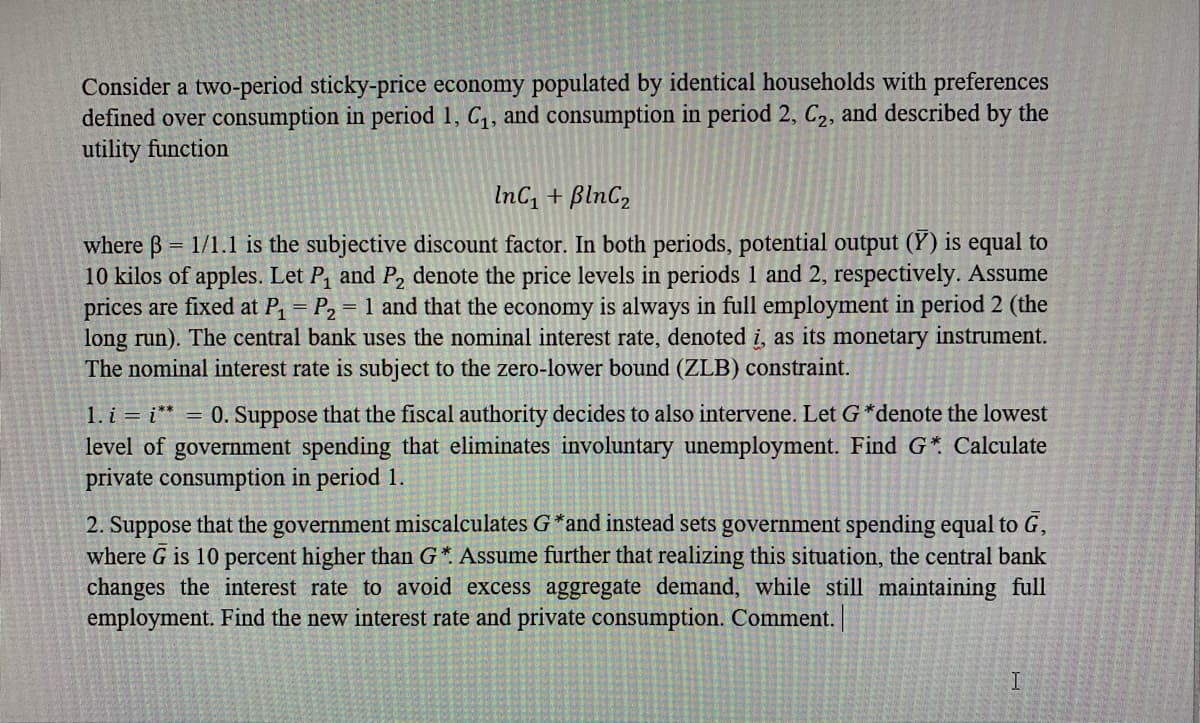Consider a two-period sticky-price economy populated by identical households with preferences defined over consumption in period 1, C₁, and consumption in period 2, C₂, and described by the utility function InC₁ + plnC₂ = where B 1/1.1 is the subjective discount factor. In both periods, potential output (Y) is equal to 10 kilos of apples. Let P₁ and P₂ denote the price levels in periods 1 and 2, respectively. Assume prices are fixed at P₁ = P₂ = 1 and that the economy is always in full employment in period 2 (the long run). The central bank uses the nominal interest rate, denoted i, as its monetary instrument. The nominal interest rate is subject to the zero-lower bound (ZLB) constraint. 1. i = i** = 0. Suppose that the fiscal authority decides to also intervene. Let G*denote the lowest level of government spending that eliminates involuntary unemployment. Find G* Calculate private consumption in period 1. 2. Suppose that the government miscalculates G*and instead sets government spending equal to where G is 10 percent higher than G* Assume further that realizing this situation, the central bank changes the interest rate to avoid excess aggregate demand, while still maintaining full employment. Find the new interest rate and private consumption. Comment.
Consider a two-period sticky-price economy populated by identical households with preferences defined over consumption in period 1, C₁, and consumption in period 2, C₂, and described by the utility function InC₁ + plnC₂ = where B 1/1.1 is the subjective discount factor. In both periods, potential output (Y) is equal to 10 kilos of apples. Let P₁ and P₂ denote the price levels in periods 1 and 2, respectively. Assume prices are fixed at P₁ = P₂ = 1 and that the economy is always in full employment in period 2 (the long run). The central bank uses the nominal interest rate, denoted i, as its monetary instrument. The nominal interest rate is subject to the zero-lower bound (ZLB) constraint. 1. i = i** = 0. Suppose that the fiscal authority decides to also intervene. Let G*denote the lowest level of government spending that eliminates involuntary unemployment. Find G* Calculate private consumption in period 1. 2. Suppose that the government miscalculates G*and instead sets government spending equal to where G is 10 percent higher than G* Assume further that realizing this situation, the central bank changes the interest rate to avoid excess aggregate demand, while still maintaining full employment. Find the new interest rate and private consumption. Comment.
Chapter17: Capital And Time
Section: Chapter Questions
Problem 17.1P
Related questions
Question

Transcribed Image Text:Consider a two-period sticky-price economy populated by identical households with preferences
defined over consumption in period 1, C,, and consumption in period 2, C2, and described by the
utility function
InC, + BlnC,
where B = 1/1.1 is the subjective discount factor. In both periods, potential output (Y) is equal to
10 kilos of apples. Let P, and P, denote the price levels in periods 1 and 2, respectively. Assume
prices are fixed at P, = P2 = 1 and that the economy is always in full employment in period 2 (the
long run). The central bank uses the nominal interest rate, denoted i, as its monetary instrument.
The nominal interest rate is subject to the zero-lower bound (ZLB) constraint.
1. i = i* = 0. Suppose that the fiscal authority decides to also intervene. Let G *denote the lowest
level of government spending that eliminates involuntary unemployment. Find G* Calculate
private consumption in period 1.
2. Suppose that the government miscalculates G*and instead sets government spending equal to G,
where G is 10 percent higher than G* Assume further that realizing this situation, the central bank
changes the interest rate to avoid excess aggregate demand, while still maintaining full
employment. Find the new interest rate and private consumption. Comment. |
Expert Solution
This question has been solved!
Explore an expertly crafted, step-by-step solution for a thorough understanding of key concepts.
Step by step
Solved in 4 steps with 2 images

Knowledge Booster
Learn more about
Need a deep-dive on the concept behind this application? Look no further. Learn more about this topic, economics and related others by exploring similar questions and additional content below.Recommended textbooks for you

